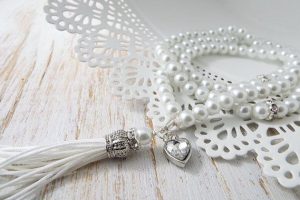 Islam is the perfect code of life. It provides complete guidance in all spheres of life and teaches man how to conduct and how to fulfil his worldly and deeni needs. Islam advocates respecting human rights and promotes sublime conduct when interacting with the creation. In aspects of honesty, trustworthiness, kindness to parents, respect to elders, and decency in manner, speech and dressing, Islam is second to none. From among the core values that Islam encourages one to adopt is the quality of Hayaa (shame and modesty). In essence, Hayaa is the stepping stone to acquiring the true morals, values and ethics of Islam. After examining the various laws and injunctions of Islam, whether relating to the domestic, social or economic aspects of one’s life, one will reach the conclusion that the element of Hayaa forms an integral part of all practices. Rasulullah (sallallahu ‘alaihi wasallam) has said:
Islam is the perfect code of life. It provides complete guidance in all spheres of life and teaches man how to conduct and how to fulfil his worldly and deeni needs. Islam advocates respecting human rights and promotes sublime conduct when interacting with the creation. In aspects of honesty, trustworthiness, kindness to parents, respect to elders, and decency in manner, speech and dressing, Islam is second to none. From among the core values that Islam encourages one to adopt is the quality of Hayaa (shame and modesty). In essence, Hayaa is the stepping stone to acquiring the true morals, values and ethics of Islam. After examining the various laws and injunctions of Islam, whether relating to the domestic, social or economic aspects of one’s life, one will reach the conclusion that the element of Hayaa forms an integral part of all practices. Rasulullah (sallallahu ‘alaihi wasallam) has said:
لكل دين خلق وخلق الإسلام الحياء
Every religion has a distinguishing characteristic, and the distinguishing characteristic of Islam is Hayaa.
An Embodiment of Hayaa
The Mubaarak lifestyle of Rasulullah (sallallahu ‘alaihi wasallam) was an embodiment of Hayaa. From his ibaadat to his eating, sleeping, interacting and even attending the call of nature, every action portrayed the highest levels of shame and modesty. In every dimension of his Mubaarak life, he ensured that the desired degree of Hayaa was never compromised. Special importance was always shown to adopting the highest level of Hayaa in one’s dress and attire, and ensuring that a believer is completely distinct from the kuffaar.
In the initial stages of Islam, when Rasulullah (sallallahu ‘alaihi wasallam) and the Sahaabah were in Makkah Mukarramah, the disbelievers would make every effort to relentlessly persecute and harass the Muslims. During this period of difficulty, an incident transpired that clearly highlights the concern for upholding the pillar of Hayaa that burned within the blessed heart of Rasulullah (sallallahu ‘alaihi wasallam).
Haarith bin Haarith narrates: I asked my father, “Who are these people?” (referring to a group of people around Rasulullah [sallallahu ‘alaihi Wasallam]). My father replied, “They are a group who are gathering around a person regarding whom they have considered to oppose their ancestral religion.” When we dismounted, we saw that the person who was surrounded by people was Rasulullah (sallallahu ‘alaihi wasallam). Rasulullah (sallallahu ‘alaihi wasallam) was inviting them to bring imaan in the oneness of Allah. The people, however, continued to reject his message and harm him. This continued until it was eventually midday and the people dispersed. At that point, a girl came to Rasulullah (sallallahu ‘alaihi wasallam) bearing a bowl of water and a cloth. The area below her neck was slightly exposed. Rasulullah (sallallahu ‘alaihi wasallam) took the bowl from her, drank some of the water and then made wudhu. He then raised his head towards her, and seeing that a portion of the area below her neck was exposed, he said to her, “O my beloved daughter! Cover your neck and do not fear for your father!” We enquired as to who the girl was and were told, “This is Hazrat Zainab (radhiyallahu ‘anha), the beloved daughter of Rasulullah (sallallahu ‘alaihi wasallam).”
The concern for Hayaa in the heart of Rasulullah (sallallahu ‘alaihi wasallam) was so great that even though it was just moments after being harmed and harassed by the disbelievers, when he saw that the area below the neck of his respected daughter had become exposed, he immediately instructed her to cover it.
Hayaa in Clothing
Every human being is born with several basic needs. Among the basic needs is the need for clothing. Allah Ta‘ala declares: “O children of (Aadam ‘alaihis salaam) ! We have sent down to you clothing to cover your nudity as well as to be an adornment for you, and the garment of piety is the best (7:26).” By mentioning the aspect of covering the body before the aspect of adorning the body, the Qur’an Kareem impresses upon us that the primary object of clothing (i.e. to cover one’s satr) is more important than its secondary benefits (i.e. adornment). Hence, if the clothing does not adequately cover one’s body, thus leaving part of the satr (area that is waajib to conceal) visible, then such a person, though clothed, will be regarded as naked in the eyes of Shariah. Rasulullah (sallallahu ‘alaihi wasallam) has prophesized the coming of such crucial and critical times in the ummah where women will be clothed yet naked.
Hazrat Abu Hurairah (radhiyallahu ‘anhu) mentioned that Rasulullah (sallallahu ‘alaihi wasallam) said, “There will be women in my ummah who although clothed, will still be naked (i.e they will wear tight fitting or transparent clothing, or clothing that does not conceal the entire body), they will attract men to themselves, and they themselves will be attracted to men. They will neither enter Jannah, nor will they perceive its fragrance, even though its fragrance is perceivable from a distance of five hundred years.” (Saheeh Muslim #21 28; Muwatta Maalik #3384)
Not Revealing the Shape of the Body
The purpose of clothing is to cover one’s shame. Hence, it should conceal the body as well as conceal the shape of the body. If the clothing covers the entire body but is tight fitting, then on account of it revealing the shape of the body, it will not be worthy of being called clothing. The woman who wears such clothing will be included among those referred to by the Hadith as ‘clothed yet naked’.
On one occasion, Hazrat Asmaa (radhiyallahu ‘anha), the respected sister of Hazrat Aaisha (radhiyallahu ‘anha), entered the home wearing a thin garment. Rasulullah (sallallahu ‘alaihi wasallam) disapproved of this type of clothing for the women of his ummah and immediately corrected her. He explained to her that the entire body of a woman should be covered in a manner that together with the cloth being non-transparent, even the shape of the body should not be discernible. (Sunan Abi Dawood #4106)
This lesson of Hayaa, taught in a very respectful manner by the master (sallallahu ‘alaihi wasallam), was so deeply entrenched in the heart of Hazrat Asmaa (Radhiyallahu ‘anha) that it remained with her till the end of her life. Hence, it is reported that when she reached old age, her beloved son Hazrat Munzir bin Zubair (radhiyallahu ‘anhuma), after returning from Iraq, sent her a cloth as a gift which was of very fine and superior quality. She had lost her sight, and so held the fabric in her hand feeling it carefully. Then with disappointment she said: “Return the gift to him.” When the cloth was returned to Munzir (radhiyallahu ‘anhu), he was hurt at this. He came to Hazrat Asmaa (radhiyallahu ‘anha) and said to her: “O my beloved mother, the cloth is not transparent! (Hence, it is fine for you to wear).” Hazrat Asmaa (radhiyallahu ‘anha) replied: “Even though it is not transparent, however due to it being tight, it will still reveal the shape of the body.” He thereafter bought for her common garments made in Marw and Quhistaan. She accepted them saying, “It is these types of garments that you should give me to wear.” (Attabaqaatul Kubra li ibn Sa’d, pg. 199)
One can well imagine what will be the response of our beloved Rasulullah (sallallahu ‘alaihi wasallam) and the Sahaabah (radhiyallahu ‘anhum) if they were to witness the tight fitting and body revealing clothing worn by the Muslim women of today.
The Clothing being Non-Transparent
Similarly, it is incumbent upon a woman to wear non-transparent clothing. Rasulullah (sallallahu ‘alaihi wasallam) has greatly stressed and emphasised that the clothing should not be transparent, thereby revealing the body of the woman beneath it. Hazrat Dihyah Kalbi (radhiyallahu ‘anhu) narrates that Rasulullah once received some Egyptian cloths as a gift. Rasulullah (sallallahu ‘alaihi wasallam) then took one of the cloths and gave it to me saying, “Cut it in half, and make a kurta with one half, and give the other half to your wife so that she can wear it as a scarf.” Then, as Rasulullah (sallallahu ‘alaihi wasallam) turned to leave, he said, “And remember to instruct your wife to place a cloth beneath the scarf so that her hair is not revealed (due to the thinness of the cloth).” (Sunan Abi Dawood #4116)
Not Emulating the Ways and Styles of the Kuffaar
Rasulullah (sallallahu ‘alaihi wasallam) commanded the ummah to refrain from emulating the ways and culture of the kuffaar. While emulating the kuffaar can occur in many aspects of life, the most obvious and apparent is in the aspect of appearance and dressing. The appearance and dressing which one adopts makes it apparent as to whom he identifies with. Furthermore, it is generally witnessed that the clothing which one wears influences and has an impact on one’s behavior and conduct. Similarly, one’s principles and values are gradually moulded and fashioned in accordance to his attire and dressing. The influence of appearance and dressing is so significant that even the kuffaar perceive its far-reaching effects. The banning of Muslim women from wearing scarves and hijaab in some countries is clear testament to this and speaks volumes of the fact that Islamic dressing and appearance has a tremendous impact on others. The kuffaar thus wish to ban the visible identity of Muslims and force them to follow their ways and culture. Allah Ta‘ala says:
وَلَن تَرضىٰ عَنكَ اليَهودُ وَلَا النَّصـٰرىٰ حَتّىٰ تَتَّبِعَ مِلَّتَهُم
The Jews and Christians will never be satisfied with you until you follow their religion. (Surah Baqarah, Aayah 120)
Thus, when the dressing and appearance taught by Rasulullah (sallallahu ‘alaihi wasallam) is not adhered to and the kuffaar are imitated, it often becomes difficult or even impossible to distinguish a Muslim from a Jew, Christian or an Atheist.
Adopting Niqaab
Donning the niqaab for women is compulsory in Islam. The purpose of the niqaab is in order for a woman to protect herself from the gazes of strange men. Allah Ta‘ala says in the Holy Qur’an, “O Nabi (sallallahu ‘alaihi wasallam), command your wives, daughters and believing women to don the niqaab (veil).” (33:59). In another verse, Allah Ta‘ala , while commanding the wives of Rasulullah (sallallahu ‘alaihi wasallam) in particular (and the believing women of this ummah in general to observe purdah), Allah Ta‘ala says, “That (observing purdah) is better for the purity of your hearts (men) and their hearts (women).” (33:53). We thus understand from these verses that observing purdah between non mahram males and females is a command of the Qur’an and from the dictates of Hayaa. Hazrat Ummu Salamah (radhiyallahu ‘anha) mentioned, “Once Hazrat Maymoonah (radhiyallahu ‘anha) and I were seated with Rasulullah (sallallahu ‘alaihi wasallam). It was just then that Hazrat Abdullah bin Ummi Maktoom (radhiyallahu ‘anhu) (the blind Sahaabi) came into the presence of Rasulullah (sallallahu ‘alaihi wasallam). Rasulullah (sallallahu ‘alaihi wasallam) immediately commanded Hazrat Maymoonah (radhiyallahu ‘anha) and I to observe purdah from this Sahaabi. I said, “O Nabi of Allah, isn’t he blind and unable to see us (i.e. what is the need for us to make purdah from him)?” Rasulullah (sallallahu ‘alaihi wasallam) retorted, “Are you two also blind?” (i.e. since you can see him, you should observe purdah from him).
Hazrat Ummu Salamah and Hazrat Maymoonah (radhiyallahu ‘anhuma) are both the respected wives of Rasulullah (sallallahu ‘alaihi wasallam) and the mothers of the ummah. Despite them being the purest of women, Rasulullah (sallallahu ‘alaihi wasallam) instructed them to observe purdah even from a blind Sahaabi. When this was the command which was applicable in the golden era of Rasulullah (sallallahu ‘alaihi wasallam), then how then can the women of this age and time -a time engulfed in fitnah- consider themselves exempt from upholding this law of Shariah in their lives?
Incident of Hazrat Ummu Khallaad (radhiyallahu ‘anha)
The son of Hazrat Ummu Khallaad (radhiyallahu ‘anha) was martyred. When she heard about it she came to Rasulullah (sallallahu ‘alaihi wasallam) to enquire about his position and reward. Despite being afflicted by the great tragedy of losing her son, her face was still covered with a niqaab. A person was quite astonished by this (level of composure) and he remarked: “You have come to enquire about your son (who was martyred) yet you (are so composed that you) have still covered your face (in this tragic moment)?” She replied: “I may have lost my son, but I have not lost my modesty.” (Sunan Abi Dawood #2488)
The remarkable lesson this great Sahaabiyah has left behind in her legacy for the mothers and daughters of this ummah is that a woman can bear the tragedy of losing her son, but undoubtedly she cannot bear the tragedy of losing her hayaa through removing her niqaab and exposing her face before non mahrams.
Not Emulating the Dressing of Men
The Deen of Islam has prescribed certain laws and injunctions that are specific to men, and other laws and injunctions that are specific to women. If one has to examine these laws and injunctions, one will realize that Islam has clearly defined a separate role for men and a separate role for women. When Allah Ta‘ala has assigned separate roles to men and women and made them completely distinct from one another, they by emulating one another, they oppose the divine command and system of Allah Ta‘ala. It is for this reason, we find that Rasulullah (sallallahu ‘alaihi wasallam) expressed great disapproval over women emulating men in their ways. It is reported that on one occasion a woman passed by Rasulullah (sallallahu ‘alaihi wasallam) carrying a bow around her neck (in the spirit to emulate the soldiers of Deen). Rasulullah (sallallahu ‘alaihi wasallam) observing this scene, said “May Allah’s curse fall on those men that emulate women and those women that emulate men in their ways.” (At-Targheeb Wat-Tarheeb #3139)
Apart from the general Ahaadith in which Rasulullah (sallallahu ‘alaihi wasallam) has prohibited and cursed men and women who emulate each other in aspects that are exclusive to both genders respectively, there are many Ahaadith in which Rasulullah (sallallahu ‘alaihi wasallam) specifically prohibited and cursed those men and women who emulate each other in the aspect of clothing and dress. Hence, Hazrat Ibnu Abi Mulaikah (radhiyallahu ‘anhu) reports that Hazrat Aaisha (radhiyallahu ‘anha) was once asked regarding whether it was permissible for a woman to wear men’s sandals. Hazrat Aaisha (radhiyallahu ‘anha) disapproved of this and replied, “Rasulullah (sallallahu ‘alaihi wasallam) cursed those women who imitate men.” (Sunan Abi Dawood #4101)
Similarly, Imaam Abu Dawood (rahimahullah) narrates that Imaam Ahmad bin Hambal (rahimahullah) was once asked whether a man could dress his slave girl in a kurta. Imaam Ahmed (rahimahullah) replied, “He should not dress her in men’s clothing. He should refrain from making her resemble men in their attire.” Imaam Abu Dawood (rahimahullah) asked Imaam Ahmed (rahimahullah), “Can he make her wear a man’s sandal?” Imaam Ahmed (rahimahullah) answered, “No, except if it is to make wudhu.” Imaam Abu Dawood (rahimahullah) asked, “Can she wear it for beauty?” Imaam Ahmed (rahimahullah) replied, “No.” Imaam Abu Dawood (rahimahullah) finally asked, “Can he cut her hair?” Imaam Ahmed (rahimahullah) answered, “No, it is not permissible for him to cut her hair.” (Masaa’ il Imaam Ahmed (rahimahullah) pg. 351)
Hayaa in the Home
Just as we have understood from the above that every aspect of the religion of Islam relating to women revolves around modesty and shame, similarly, we find that Islam has commanded women to remain within the confines of their homes, being totally concealed from the gazes of strange men and not to leave their homes without a valid Sharee need. Rasulullah (sallallahu ‘alaihi wasallam) commanded his beloved daughter, Hazrat Faatimah (radhiyallahu ‘anha), at the time of her Nikaah with Hazrat Ali (radhiyallahu ‘anhu) to remain within her home and fulfil the responsibilities of the home. Similarly, Rasulullah (sallallahu ‘alaihi wasallam) had commanded Hazrat Ali (radhiyallahu ‘anhu) to fulfil the responsibilities out of the home. In this way,Rasulullah (sallallahu ‘alaihi wasallam) showed the ummah the roles of both, males and females.
A Muslim woman should understand that she owes her allegiance and loyalty to Allah Ta‘ala at every moment, whether she is in the home or out of the home, or whether she is out on a journey or associating with her family at a family function. Wherever she may be, she should be mindful of her obligation to her Creator and uphold the standards of Hayaa within her life. Even in the confines of her home, she should ensure that she is clad modestly. At times, there are other people present in the home with whom observing purdah is compulsory e.g. the male servants or other non mahram family members. Hence, at no time should she reveal her face, hair or any portion of her body that has to be covered before them. Similarly, she should not wear tight fitting or revealing clothing in their presence.
If there are no non mahrams present in the home, though it will be permissible for her to adorn herself and expose her hair before her husband and children, she should bear in mind that she has to impart Islamic values to her children and be a role model for them to follow. She should therefore ensure that she dresses modestly at all times and does not wear revealing or tight-fitting clothing in the home. Similarly, she should cover her hair at all times so that she is not deprived of the company of the Malaaikah.
Guidelines of Shariah regarding Women’s Clothing
Shariah has provided extensive guidelines in regard to the description of the clothing a woman should cover herself with. Below is the description of an Islamic dress a woman should adorn herself with:
- The clothing must provide cover for her entire body, otherwise in the eyes of Shariah they will not be worthy of being called “clothes.” It is compulsory upon a woman to cover her entire body and hair (with the exception of her hands till her wrists and feet) before non-mahrams (strange men).
- The clothing must be such that it should neither be transparent nor should it reveal the shape of the body. Hence if the clothing is tight-fitting to the extent that the shape of the satr is discernable, such a woman is also included in the description of the Hadith of being “clothed yet naked.”
- The type of clothing that is essentially worn by one gender should not be worn by the opposite gender. Rasulullah (sallallahu ‘alaihi wasallam) said: “Allah Ta‘ala has cursed those men who emulate women (in dressing, etc.) and those women who emulate men.” (Tabraani #4003)
- The clothing they wear should not emulate the styles and fashions of the disbelievers. Rasulullah (sallallahu ‘alaihi wasallam) said, “The one who emulates a people will be counted amongst them (in the sight ofAllah Ta‘ala).” (Sunan Abi Dawood #4031)
- The clothing should neither be worn for show nor should there be extravagance in it.
- When leaving the home, a woman should ensure that the laws of Hayaa and modesty are maintained. The Hadith commands that she should dress in an unattractive manner, should not apply perfume and she must don the niqaab. It is a fact of life that there exists a basic natural inclination towards the opposite gender. Wearing attractive clothing further incites such inclination which leads to fitna. Rasulullah (sallallahu ‘alaihi wasallam) mentioned, “The woman who applies perfume and thereafter passes by a group of men so that they may perceive her fragrance is (like) an adulteress.” (Sunan Nasai #5141)
Hayaa in Salaah
The manner in which a woman is commanded to perform her Salaah – commencing from her attire for Salaah to her postures during Salaah – all clearly point towards the aspect of concealment. Hence, let alone the various other Ibadaat of Deen, the Salaah of a woman alone illustrates the great degree of modesty and shame a woman is required to display. Hence, she is commanded to adopt the very same degree of modesty and shame in other departments of her Deeni and worldly life which she displays in her Salaah.
Performing Salaah in Transparent or Tight Fitting Clothing
A female should ensure that her entire body is covered with clothes that are non-transparent and loose fitting. Similarly the clothing should be such that it does not reveal the shape of the body. If the clothing is see-through and the body beneath is visible, then the Salaah will not be valid. Furthermore, the clothing should be of such a nature that it is keeping to the highly esteemed position of Salaah and of standing before Allah Ta‘ala. Hence it is best for a female to wear a namaaz burqa or a loose abaayah at the time of standing before Allah Ta‘ala in Salaah.
 Ihyaaud Deen An Effort to Revive Deen in Totality
Ihyaaud Deen An Effort to Revive Deen in Totality



